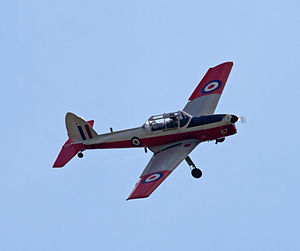De Havilland Canada DHC-1 Chipmunk
| DHC-1 Chipmunk | |
|---|---|
 |
|
| A Chipmunk 1 in 2013 | |
| Role | Trainer |
| Manufacturer | de Havilland Canada |
| Designer | Wsiewołod Jakimiuk |
| First flight | 22 May 1946 |
| Introduction | 1946 |
| Retired | 1972 (Canada) |
| Status | Out of production, in active service |
| Primary users |
Royal Air Force Royal Canadian Air Force Portuguese Air Force Belgian Air Force |
| Produced | 1947-1956 |
| Number built | 1,284 (including Canadian, British, and Portuguese production) |
The de Havilland Canada DHC-1 Chipmunk is a tandem, two-seat, single-engined primary trainer aircraft developed and manufactured by Canadian aircraft manufacturer de Havilland Canada. It was developed shortly after the Second World War and sold heavily throughout the immediate post-war years, being typically employed as a replacement for the de Havilland Tiger Moth biplane.
The Chipmunk holds the distinction of being the first postwar aviation project conducted by de Havilland Canada. It performed its maiden flight on 22 May 1946 and was introduced to operational service that same year. During the late 1940s and 1950s, the Chipmunk was procured in large numbers by military air services such as the Royal Canadian Air Force (RCAF), Royal Air Force (RAF), and several other nation's air forces, where it was often utilised as their standard primary trainer aircraft. The type was also produced under licence by de Havilland in the United Kingdom, who would produce the vast majority of Chipmunks, as well as by OGMA (Oficinas Gerais de Material Aeronáutico) in Portugal.
The type was gradually phased out of service from the late 1950s onwards, often being replaced by jet-propelled trainers such as the BAC Jet Provost. Few aircraft were left in military service by 1970. However, many of the Chipmunks that had been formerly in military use were resold on to civilians, either to private owners or to companies, where they were typically used for a variety of purposes, often involving the type's excellent flying characteristics and it capability for aerobatic maneouvers. More than 70 years after the type having first entered service, hundreds of Chipmunks remained airworthy and were in operation around the world.
...
Wikipedia
